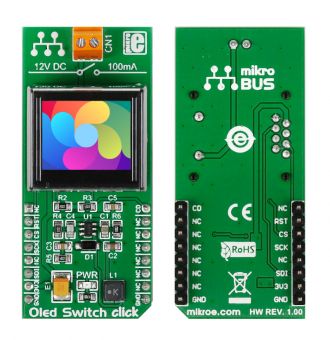
We strongly encourage users to use Package manager for sharing their code on Libstock website, because it boosts your efficiency and leaves the end user with no room for error. [more info]

Rating:
Author: MIKROE
Last Updated: 2019-07-30
Package Version: 1.0.0.1
mikroSDK Library: 1.0.0.0
Category: OLED
Downloaded: 5637 times
Not followed.
License: MIT license
This board has a module that combines a button and a full color organic LED display, plus input/output screw terminals for connecting external electronics.
The mechanical button itself is nicely built, with a translucent black housing. When pressed, it gives satisfying tactile feedback.
Do you want to subscribe in order to receive notifications regarding "OLED Switch click" changes.
Do you want to unsubscribe in order to stop receiving notifications regarding "OLED Switch click" changes.
Do you want to report abuse regarding "OLED Switch click".

Library Description
The library covers all the necessary functions that enables the usage of the OLED Switch click.
It initializes and defines the SPI driver and drivers that offer a choice for applying different types of settings and for drawing images on the OLED display.
Key functions:
void oledswitch_displayNormalMode() - Function is used to enable display normal mode.void oledswitch_draw565Img( const uint8_t *img, uint16_t imgSize ) - Function takes a 565 formatted array and writes it to the OLED switch's memory.void oledswitch_scrollingSetup( scroll_t setup ) - Function is used to set up the OLED Switch click for scrolling.Examples description
The application is composed of three sections :
void applicationTask()
{
oledswitch_draw565Img( _OLEDSWITCH_BMP_RED, _OLEDSWITCH_IMG_SIZE );
Delay_ms( 1000 );
oledswitch_draw565Img( _OLEDSWITCH_BMP_GREEN, _OLEDSWITCH_IMG_SIZE );
Delay_ms( 1000 );
oledswitch_draw565Img( _OLEDSWITCH_BMP_BLUE, _OLEDSWITCH_IMG_SIZE );
Delay_ms( 1000 );
}
Other mikroE Libraries used in the example:
Additional notes and informations
Depending on the development board you are using, you may need USB UART click, USB UART 2 click or RS232 click to connect to your PC, for development systems with no UART to USB interface available on the board. The terminal available in all MikroElektronika compilers, or any other terminal application of your choice, can be used to read the message.